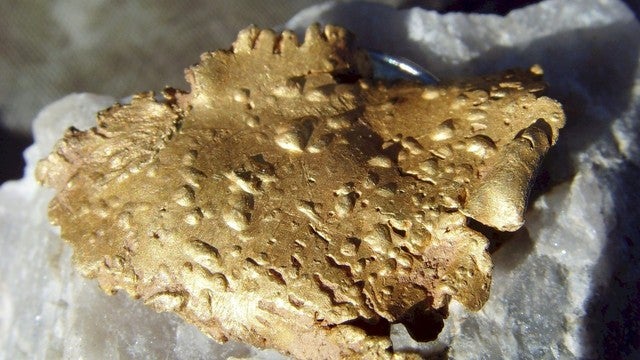
The Willbob project covers several tens of kilometres of favourable stratigraphy and structures with strong gold potential in the Labrador Trough. This first exploration campaign for 2019 will include prospecting and geological mapping and will take place over a period of two weeks.
Ants showing area
Prospecting work carried out under this new program will focus on the extensions of the Ants showing discovered in 2018. The Ants gold zone is exposed on outcrop over a surface area of at least 50 metres long by 5 to 24 metres wide. Channel samples collected in 2018 yielded the following values: 1.78 g/t Au over 23.3 metres, including 3.19 g/t Au over 10.0 metres (channel ANTS-18-03); 3.33 g/t Au over 5.0 metres (channel ANTS-18-02); and 2.22 g/t Au over 4.5 metres (channel ANTS-18-04). The Ants showing is open to the southeast (along strike) and to the southwest (across width), underneath surficial deposits. It consists of a large outcropping area where disseminated pyrrhotite and chalcopyrite, as well as quartz veinlets, are hosted in a diorite with strong chlorite and ankerite alteration. Note that grab samples are selective by nature and are not representative of mineralized zones. The true thickness of mineralized zones intersected by channel samples has not been determined.
New claim blocks
A new claim block was map-designated by Midland northwest of the Ants showing area. This block of 40 claims lies directly along the possible northwest extension of the Ants showing. Airborne electromagnetic anomalies, diorites mapped by the MERN, and lake sediment anomalies are present on this new claim block.
Another block of 81 claims was map-designated in the Lac Canyon area, approximately 30 kilometres to the southeast, near the Kan showing held by Osisko Mining Inc (“Osisko”). This new claim block encompasses a historic gold occurrence dubbed “Baby One More Time”, explored by Osisko in 2017 (0.76 g/t Au over 7 m, including 3.29 g/t Au over 1 m (GM 70728)). The claim block also hosts copper occurrences, where grab samples reported by the MERN yielded values of 0.65% Cu at Lac du Canyon-NE, and 0.8% Cu at Lac du Canyon-Nord. Finally, a block of 12 claims was map-designated along the Robelin fault, 5 kilometres west of the Ants showing. This claim block covers diorites mapped by the MERN as well as gold and zinc lake sediment anomalies.
2019 fieldwork
Prospecting work conducted in July 2019 will focus on the Ants showing area, as well as on the new recently acquired claim blocks, including the possible northwest extension of the Ants showing.
A second phase of fieldwork is planned in September 2019. This second phase will include further prospecting work as well as a drilling campaign totalling approximately 1,000 metres, focussing mainly on the Ants showing, with a few drill holes planned further east on the Stars showing.
Quality Control
Exploration program design and interpretation of results is performed by qualified persons employing a Quality Assurance/Quality Control program consistent with industry best practices, including the use of standards and blanks with every 20 samples. Rock samples on the project are assayed for gold by standard 30-gram fire-assaying with AA (Au-AA23) or gravimetric finish (Au-GRA21) at ALS Minerals laboratories in Val d’Or, Québec. Samples with visible gold or above 1.0 g/t Au were further analyzed by metallic screen with fire assays (Au-SCR21) ; Au-SCR21 values were used to calculate gold intervals when available. All samples are also analysed for multi-elements, using four-acid ICP–AES method (ME-ICP61) at ALS Minerals laboratories in Vancouver, British Columbia.
Source: Company Press Release






